

Digital curation. The term curation in the past commonly referred to museum and library professionals.

It has since been applied to interaction with social media including compiling digital images, web links and movie files. Approaches to digital curation[edit] The Digital Curation Centre is a "world leading centre of expertise in digital information curation"[5] that assists higher education research institutions. The DCC is based in the UK and began operations in early 2004. The following is a general outline of their approach to digital curation: Conceptualize: Consider what digital material you will be creating and develop storage options. Sheer curation[edit] Sheer curation is an approach to digital curation where curation activities are quietly integrated into the normal work flow of those creating and managing data and other digital assets. A similar idea is curation at source used in the context of Laboratory Information Management Systems LIMS. Software as a service. According to a Gartner Group estimate, SaaS sales in 2010 reached $10 billion, and were projected to increase to $12.1bn in 2011, up 20.7% from 2010.[6] Gartner Group estimates that SaaS revenue will be more than double its 2010 numbers by 2015 and reach a projected $21.3bn.

Customer relationship management (CRM) continues to be the largest market for SaaS. SaaS revenue within the CRM market was forecast to reach $3.8bn in 2011, up from $3.2bn in 2010.[7] Social networking service. A social networking service (also social networking site or SNS) is a platform to build social networks or social relations among people who share interests, activities, backgrounds or real-life connections.
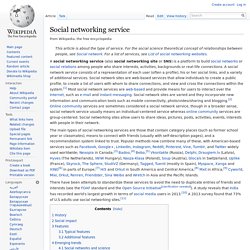
A social network service consists of a representation of each user (often a profile), his or her social links, and a variety of additional services. Social network sites are web-based services that allow individuals to create a public profile, to create a list of users with whom to share connections, and view and cross the connections within the system.[1] Most social network services are web-based and provide means for users to interact over the Internet, such as e-mail and instant messaging. §History[edit] Category:Web syndication. Feedly. Category:Community websites. SlideShare. The website gets an estimated 58 million unique visitors a month,[7] and has about 16 million registered users.
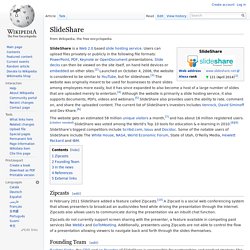
[citation needed] SlideShare was voted among the World's Top 10 tools for education & e-learning in 2010.[8][9] SlideShare's biggest competitors include Scribd.com, Issuu and Docstoc. Some of the notable users of SlideShare include The White House, NASA, World Economic Forum, State of Utah, O'Reilly Media, Hewlett Packard and IBM. §Zipcasts[edit] In February 2011 SlideShare added a feature called Zipcasts.[10] A Zipcast is a social web conferencing system that allows presenters to broadcast an audio/video feed while driving the presentation through the Internet. Zipcasts also allows users to communicate during the presentation via an inbuilt chat function. Pearltrees. Pearltrees refers to itself as "a place for your interests".[8] Functionally the product is a visual and collaborative curation tool[9][10][11][12] that allows users to organize, explore and share any URL they find online as well as to upload personal photos, files and notes.[13] The product features a unique visual interface[14][15] that allows users to drag and organize collected URLs, and other digital objects.[16] that themselves can be further organized into collections and sub-collections,[17] (URLs).
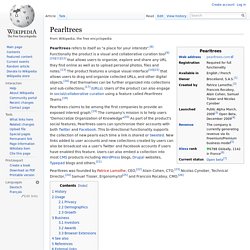
Users of the product can also engage in social/collaborative curation using a feature called Pearltrees Teams.[18] Pearltrees was founded by Patrice Lamothe, CEO,[22] Alain Cohen, CTO,[23] Nicolas Cynober, Technical Director,[24] Samuel Tissier, Ergonomy/UI[25] and Francois Rocaboy, CMO.[26] History[edit] Development of Pearltrees began in 2007. In July 2012 Pearltrees launched their iPhone app. Pearltrees introduced Pearltrees 2.0 on May 22nd, 2014. List of social bookmarking websites. Defunct sites[edit]

List of social networking websites. A/B testing. In marketing and business intelligence, A/B testing is jargon for a randomized experiment with two variants, A and B, which are the control and treatment in the controlled experiment.

It is a form of statistical hypothesis testing with two variants leading to the technical term, Two-sample hypothesis testing, used in the field of statistics. Other terms used for this method include bucket tests and split testing but these terms have a wider applicability to more than two variants. In online settings, such as web design (especially user experience design), the goal is to identify changes to web pages that increase or maximize an outcome of interest (e.g., click-through rate for a banner advertisement). Formally the current web page is associated with the null hypothesis.
Goodreads. Goodreads is an Amazon company and "social cataloging" website founded in December 2006 and launched in January 2007 by Otis Chandler, a software engineer and entrepreneur, and Elizabeth Chandler.[2][3] The website allows individuals to freely search Goodreads' extensive user-populated database of books, annotations, and reviews.
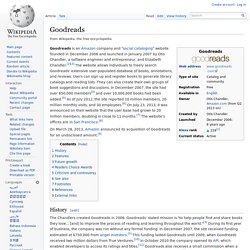
Users can sign up and register books to generate library catalogs and reading lists. They can also create their own groups of book suggestions and discussions. In December 2007, the site had over 650,000 members[4] and over 10,000,000 books had been added.[5] As of July 2012, the site reported 10 million members, 20 million monthly visits, and 30 employees.[6] On July 23, 2013, it was announced on their website that the user base had grown to 20 million members, doubling in close to 11 months.[7] The website's offices are in San Francisco.[8]
Shelfari. Shelfari was launched on October 11, 2006.[1] In February 2007, Amazon.com invested $1 million in Shelfari,[2] and moved to acquire it a year later in August 2008.[3] §History[edit] Shelfari was founded by RealNetworks alumni Josh Hug, Kevin Beukelman, and Mark Williamson under the name Tastemakers Inc., the former two being software developers and the latter never joining the company full-time, along with designer Ian Patterson.

The site sought to create a social networking service that met the needs of avid readers. This strategy may have mirrored a trend during this time period of creating niche social networks such as social movie site Flixster. White paper. A white paper is an authoritative report or guide helping readers understand an issue, solve a problem, or make a decision.[1] White papers are used in two main spheres: government and business-to-business marketing.
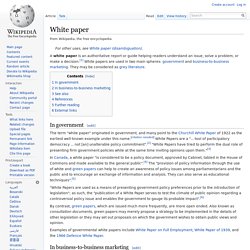
They may be considered as grey literature. In government[edit] The term "white paper" originated in government, and many point to the Churchill White Paper of 1922 as the earliest well-known example under this name. Publicité mobile. Un article de Wikipédia, l'encyclopédie libre. L'apparition et la popularité des téléphones mobiles a permis l'essor de la publicité par téléphone mobile. §Enjeux de la publicité par mobile[modifier | modifier le code] Le téléphone mobile acquiert rapidement de plus en plus de fonctions et pourrait prendre la place de la télévision en tant que média principal[réf. nécessaire], pour les entreprises qui souhaiteraient atteindre leurs consommateurs. Cette piste est confirmée par Omnicom, un réseau d'agence publicitaires[réf. nécessaire]. Content marketing. §History[edit] 10g Backin package (1902) Advertising has long used content to disseminate information about a brand, and build a brand's reputation.
Email marketing. Email marketing is the act of sending a commercial message, typically to a group of people, using email. In its broadest sense, every email sent to a potential or current customer could be considered email marketing. It usually involves using email to send advertisements, request business, or solicit sales or donations, and is meant to build loyalty, trust, or brand awareness. Marketing emails can be sent to a purchased lead list or a current customer database. The term usually refers to sending email messages with the purpose of enhancing a merchant's relationship with current or previous customers, encouraging customer loyalty and repeat business, acquiring new customers or convincing current customers to purchase something immediately, and sharing third-party ads.
Category:Internet advertising methods. Category:Internet marketing. LibraryThing. LibraryThing is a social cataloging web application for storing and sharing book catalogs and various types of book metadata. It is used by authors, individuals, libraries, and publishers. Based in Portland, Maine,[2] LibraryThing was developed by Tim Spalding and went live on August 29, 2005. As of January 2015, it has over 1,900,000 users and nearly 95 million books catalogued.[3] §Features[edit] The primary feature of LibraryThing ("LT") is the cataloging of books by importing data from libraries through Z39.50 connections and from six Amazon.com stores. Goodreads. HootSuite. Additional integrations are available via Hootsuite’s App Directory, including Instagram, MailChimp, Reddit, Storify, Tumblr, Vimeo and YouTube.[8] Based in Vancouver, British Columbia, Canada, Hootsuite has over 500 staff located in Vancouver, San Francisco, New York, Hong Kong, London, Sydney, Singapore, and other countries.
The company operates on a freemium model and has over 10 million users in more than 175 countries.[5] §History[edit] Twitscoop. Twitscoop is a web-based Twitter client which uses the Twitter API to allow users to send and receive tweets, and do multiple real-time searches at the same time. Twitter client[edit] Twitscoop is a Twitter client and a real-time visualisation tool which enables users to mine the tweet stream.[2] Twitscoop's algorithm identifies tags and keywords in the Twitter stream and then ranks them by how frequently they appear versus normal usage. Twitscoop detects growing trends in real-time, identifies breaking news and then monitors specific keywords along with graphs that display the activity for any given word on Twitter. Social networking service. Social media. Diagram depicting the many different types of social media. Marketing. Marketing 2.0.
Un article de Wikipédia, l'encyclopédie libre. L’idée de Marketing 2.0 se réfère à une nouvelle génération de concepts marketing émergents de l’ère Internet. L’expression a été popularisée en 2005 lorsque plusieurs experts parlaient également du Web 2.0. L'Adetem, l'association du marketing, y consacra en octobre 2007 ses Journées Nationales[1]. Toutefois, le vocable de Marketing 2.0 recouvre au moins deux acceptions plutôt différentes aujourd'hui : la première correspond à l'adaptation des outils Web 2.0 au marketing ; la seconde à l'élaboration d'un nouveau marketing qui dépasse le cadre du seul Internet. §Marketing 2.0 / Exploitation des outils Web 2.0 dans les actions marketing[modifier | modifier le code] L’expression fait partie du vocabulaire commun d’une nouvelle génération d’experts en marketing utilisant l’Internet comme principal outil de travail.
Les plus grandes sociétés au monde ont déjà commencé à créer des campagnes de marketing 2.0. Les marques et institutions peuvent soit: Category:Types of marketing. Display advertising. Display advertising is a type of advertising that is located on websites. Category:Google. Category:Google services. Online advertising. In 2011, Internet advertising revenues in the United States surpassed those of cable television and nearly exceeded those of broadcast television.[1]:19 In 2013, Internet advertising revenues in the United States totaled $42.8 billion, a 17% increase over the $36.57 billion in revenues in 2012.[2]:4–5 U.S. internet ad revenue hit a historic high of $20.1 billion for the first half of 2013, up 18% over the same period in 2012.[3] Online advertising is widely used across virtually all industry sectors.[1]:16 Many common online advertising practices are controversial and increasingly subject to regulation.
Online ad revenues may not adequately replace other publishers' revenue streams. Declining ad revenue has led some publishers to hide their content behind paywalls.[4] History[edit] Web analytics. Web analytics is not just a tool for measuring web traffic but can be used as a tool for business and market research, and to assess and improve the effectiveness of a website. Web analytics applications can also help companies measure the results of traditional print or broadcast advertising campaigns. It helps one to estimate how traffic to a website changes after the launch of a new advertising campaign. Analytics. Analytics is the discovery and communication of meaningful patterns in data. Especially valuable in areas rich with recorded information, analytics relies on the simultaneous application of statistics, computer programming and operations research to quantify performance.
Analytics often favors data visualization to communicate insight. Analytics vs. analysis[edit] Analytics is a multi-dimensional discipline. Online advertising. Roy Lichtenstein. Online advertising. Social television. Storify. Agrégation web. Social network aggregation. Social media measurement. Social media marketing. Viral marketing. Social media optimization. Search engine marketing.